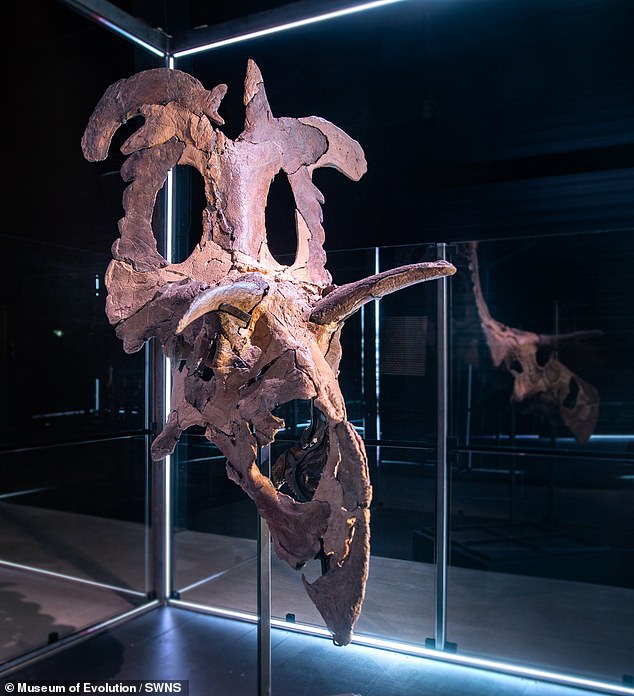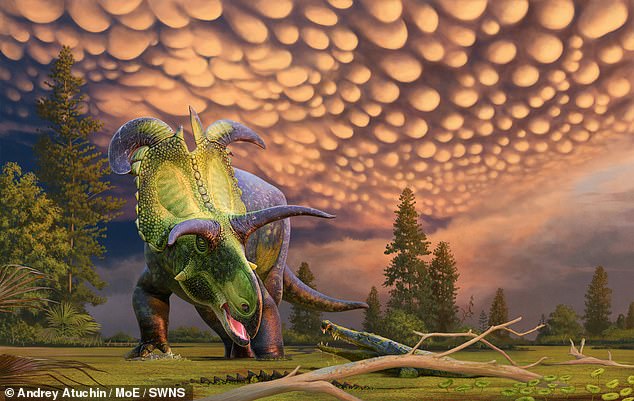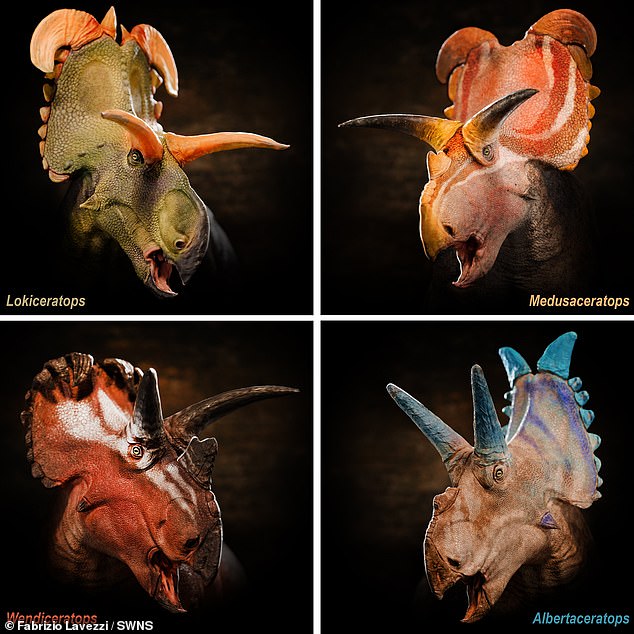A flamboyant dinosaur with extensive orange horns, hailed by researchers as a ‘sexy beast’, has been discovered in Montana’s ancient swamps
What connects flamboyant clothing, the Norse god Loki and ancient reptiles?
Surprisingly, scientists say the answer is a newly discovered horned dinosaur that roamed the swamps of Montana 78 million years ago.
Lokiceratops rangiformis – which loosely means ‘Loki’s horned face resembling a caribou’ – had some of the largest and most flamboyant horns of any dinosaur.
And at 6.7 meters long and weighing 5 tonnes, scientists say this ‘sexy beast’ is the largest horned dinosaur ever found in North America.
But according to co-discoverer of the dinosaur, Professor Mark Loewen of the University of Utah, this herbivore would have been a non-violent ‘gentle giant’.
Scientists have discovered a huge horned dinosaur whose flamboyant horns have led discoverers to dub it a ‘sexy beast’

Lokiceratops rangiformis, which loosely means “Loki’s horned face resembling a caribou,” is named after the horns and curved blades of the Norse tricker god, as popularized by Tom Hiddleston in the Marvel cinematic universe
Professor Loewen and his co-lead author Joseph Sertich of Colorado State University found Lokiceratops in the badlands of northern Montana.
Just two miles south of the Canadian border, the pair discovered fragments of a huge skull buried in the rock.
By joining together bone fragments smaller than dinner plates, the pair managed to piece together the complete skull of an undiscovered species.
Lokiceratops rangiformis is a member of the horned dinosaurs called ceratopsians, which includes the triceratops.
However, this new frilled dinosaur arrived on the scene 12 million years before its better-known relative, displaying a host of unique features.
Professor Loewen told MailOnline: ‘It was the most massive ceratopsian ever evolved by the time it lived, possessing the longest skull of any land animal that had ever lived until 78 million years ago.’
That massive skull is topped by two enormous curved, blade-like horns and an asymmetrical horn in the center that resembles a caribou’s antlers.
These unusual features gave Lokiceratops rangiformis its unusual name.

Lokiceratops had the longest skull of any animal that had ever lived until 78 million years ago when it roamed the plains of northern Montana
Professor Loewen says: ‘The dinosaur now has a permanent home in Denmark, so we went with a Norse god, and in the end doesn’t it really look like Loki with the curved blades?’
But those impressive horns were not just about violence, as Professor Loewen suggests they may have been brightly colored and patterned.
Professor Loewen told MailOnline: ‘We speculate that it had brightly colored horns as we think the horns were used as a sexual display to attract mates.’
Fringes and horns are common in the family of dinosaurs called ceratopsids and would have been a significant deterrent to potential predators.

The researchers suggest that the dinosaur’s enormous horns and blades may have served a similar purpose to birds’ colorful plumage: They helped attract mates and recognize other members of the species.
The researchers suggest that the sheer size and diversity of the ceratopsid fringes indicate that they may have served a social purpose.
Co-author Dr. Sertich says, “We think these dinosaurs’ horns were analogous to what birds do with displays: they use them for mate selection or species recognition.”
He adds: ‘These skull ornaments are one of the keys to unlocking the diversity of horned dinosaurs and show that evolutionary selection for showy displays contributed to the staggering richness of Cretaceous ecosystems.’
Importantly, the Lokiceratops skull was found in a rock layer where four other horned dinosaurs had previously been found.
This suggests that several different species could have coexisted in the swamps and coastal plains of eastern Laramidia, the western landmass of North America.

Lokiceratops (top left) was found in a rock layer with three other species from the same family (photo). This suggests that they all lived together in a small geographical area
Like birds, these horned dinosaurs evolved quickly and in a small area, developing a wide range of colorful displays.
Dr. Sertich says, “To see five of them living together is an unprecedented diversity, similar to what you would see on the plains of East Africa today with different horned ungulates.”
But twelve million years later, when Triceratops first appeared, these separate groups had been homogenized into just two species.
The researchers say this discovery gives us insight into the incredible diversity of the iconic horned dinosaurs and their complex evolutionary history.
Professor Loewen concludes: ‘Lokiceratops helps us understand that we are only scratching the surface when it comes to the diversity and relationships within the horned dinosaur family tree.’
